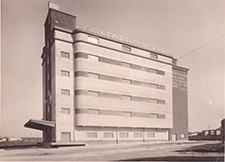In the 1930s, Mussolini’s regime (1922–1943) embarked on a large building campaign to construct granaries across the Italian peninsula and in Italian territories abroad. This building mania was a direct result of Italy’s invasion of Ethiopia in 1935: following the imposition of sanctions by the League of Nations, the regime ordered the obligatory consignment of wheat by producers to public storage facilities to centrally manage a critical alimentary resource and publicize the government’s efforts to insure national food security. In this way, fascist politics transformed the granary from banal industrial structure into symbolic architecture that conveyed self-sufficiency and embodied imperial ambitions.
The grain silo occupies a distinct place in the history and historiography of modern architecture. Walter Gropius, Le Corbusier, and Erich Mendelsohn were among the first European architects to proclaim the monumental North American grain elevator as a formal inspiration for the basic vocabulary of modernism. However, this iconic model with its soaring verticality and prominent cylindrical bins was eschewed by the fascist regime as impractical and in contradiction to Italy’s economic objectives. Fascism sought, instead, a wholly different type of grain storage with horizontal floors and flexible interiors, due in no small part to politically driven material constraints.
This talk examines two aspects of fascist Italian granaries: 1) the regime’s deliberate positioning of the granary as a mediator of seemingly contradictory roles in fascist ideologies, and 2) the ways in which fascism mediated the granary to create an illusion of food abundance to allay worries of an unstable future. Thus, the granary’s ontological position was one of betweenness that negotiated the push and pull of opposing poles, portrayed in state-sponsored media as striking a necessary balance between urban and rural, ancient and modern, and past and future. Heavily mediated, the granary as mediator was a visual palliative, a structure that represented the culmination of the regime’s arduous, decade-long battle for wheat.

